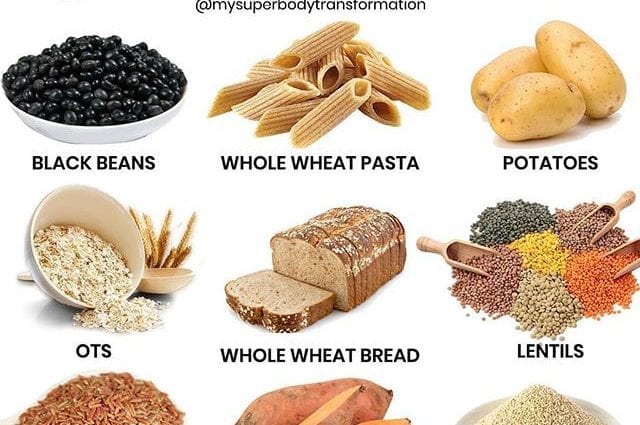Contents
Carbohydrates are an essential part of everyone’s diet to keep them energized and active throughout the day. What are carbohydrates, what are their benefits and harms, how to distinguish useful carbohydrates from harmful ones? We will understand this article.
1. What are carbohydrates.
Carbohydrates are one of the main sources of nutrients. 60% of the energy the body receives is thanks to useful carbohydrates, which are converted into glucose during processing by the digestive system. It is glucose that enters the blood that is, in the future, a kind of fuel for the body, providing you with a charge of vigor.
Depending on the chemical composition, carbohydrates are divided into simple and complex.
Simple carbohydrates, as a rule, are quickly absorbed and have a high glycemic index; with a lack of physical activity, such carbohydrates cause an increase and then a sharp decrease in sugar in the body, which leads, in the future, to a feeling of hunger. Unused carbohydrates are converted to fat, so the rate of their consumption should be as limited as possible, but you should not completely exclude simple carbohydrates from the diet, you just need to remember that simple carbohydrates should be consumed in small portions in the morning. Foods that include simple carbohydrates include: fruits, certain types of vegetables, processed cereals and cereals, flour products.
Complex carbohydrates are a source of fiber. They improve digestion and provide the body with a long-lasting feeling of fullness, due to their complex composition and long processing. Foods containing complex carbohydrates include whole grains and cereals, starchy vegetables, and legumes.
2. Harmful carbohydrates
Harmful carbohydrates are carbohydrates that, as a result of pre-processing, have become “empty”, that is, they have lost all their useful properties, and the calories that make up them have lost their nutritional value. Usually, such products have a rich taste due to sweeteners, preservatives and other harmful additives that prevail in the composition. The use of such products should be minimized, or completely excluded from the diet. Products that include harmful carbohydrates include: cakes, flour and pastries, sweet carbonated drinks, alcohol, confectionery, chocolate bars. The list is endless.
3. What carbohydrates are good for health
The greatest health benefits come from complex carbohydrates that are not cooked or moderately cooked. Foods that are most beneficial to health include: vegetables, legumes, cereals, whole grains and fruits with an average glycemic index. With the regular use of these foods, you will notice positive changes in both overall health and improved condition of hair, nails and skin, as well as healthy carbohydrates provide the body with the necessary amount of vitamins, minerals and fiber.
4. List of the most useful carbohydrates for weight loss
First, it is buckwheat, or buckwheat.
Buckwheat contains a lot of iron, as well as calcium, potassium, phosphorus, iodine, zinc, vitamins B1, B2, B9, PP, E.
Buckwheat is a very good source of fiber, magnesium and manganese.
Carbohydrates in buckwheat are relatively small, at least, and are absorbed by the body for a long time, thanks to which, after being fluent, you can feel yourself satiated for a long time.
Secondly, KINOA.
Much to our regret, in Russia this crop is almost unused, but in vain. The film was incultivated for another 3 thousand years ago, when it was called the “mother of all grains”.
Quinoa is a source of many useful substances for the human body. It contains more protein than any other grains — up to 16% by weight (ready-made), and this protein is easily digestible. In addition to the unique protein kinoa – a source of carbohydrates, fats, fiber, minerals and vitamins B, healthy fats – omega 3 and omega 6 and important antioxidants. In addition, cinema is rich in phosphorus, in the content of which it does not yield to many species of fish and is three times higher than that of the highest quality. Cinema also contains iron (twice as much as wheat), calcium, zinc, folic acid, magnesium and manganese. Cinema contains fewer carbohydrates than other grains, for example 30% less than white rice. A delicious side dish is obtained from the film. Personally he is mixed with buckwheat.
Anticipating the question, I will say: yes, the movie is on sale in Moscow supermarkets (Azbukavkusa, Perekrestok) and, of course, you can buy it in online stores.
Third, millet
Millet is a grain that I get from the fruits of cultivated types of demand. Anthropologists believe that wheat was the first grain cultivated by humans.
The protein content of wheat is not quite high, its level of wheat can be compared with wheat – about 11% of the weight. Also wheat is rich in vitamins, especially B1, B2, B5 and PP. Millet contains the necessary organisms, macro-microelements: iron, fluorine, magnesium, manganese, silicon, copper, calcium, potassium zinc.
So, if you want to find out what the secret of eternal energy is, turn on useful grains in your menu: buckwheat, quinoa, millet.
5. Tips for those wishing to lose weight.
In order to become the owner of a beautiful figure, it is not necessary to resort to exhausting diets, you need to adhere to a few simple rules, turning them into an everyday habit.
- Eat carbohydrates in the morning.
- Drink a glass or two of clean water without gas half an hour before meals. Thus, you slightly “trick” the body and can get satiated with less food.
- Do not gorge yourself. You should leave the table feeling a little satiated.
- Try to give preference to plain clean water over other drinks.
- Take time to exercise regularly if possible.










